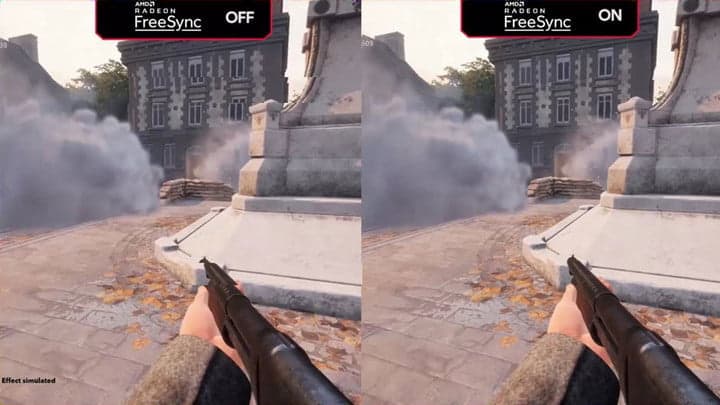You have probably heard of FreeSync and might have seen it compared to G-Sync and VSync. These are all solutions to the same problem, but the various terms can quickly become confusing. AMD’s FreeSync and its newer Superior and Premium Pro versions will be the focus of this guide.
Before we take a closer look at what these different incarnations of FreeSync bring to the table and their distinctions, it’s essential to understand the problem they’re trying to fix and other possible solutions. That problem is the dreaded screen tearing.
Table of ContentsShow
So, FreeSync Solves Screen Tearing?
It does, but it isn’t the main technology that aims to do so, nor was it the initial.
Screen tearing is a visual glitch that occurs when either the graphics card produces more frames than the monitor can display or when the monitor refreshes too rapidly for the frames that the GPU can provide.
This is particularly problematic if you have invested in a high-performance GPU while keeping your old 60Hz monitor, and you play an FPS multiplayer game only to have your environment split in two, costing you some vital kills.
To better understand FreeSync and its uses, we also need to consider similar technologies.
Vertical Synchronization – VSync

The first thing that probably comes to mind about VSync is just how long it has been a staple of PC games’ video settings. VSync can be considered the original solution for this problem. Although it’s far from perfect, it does produce positive results.
In essence, vertical synchronization will lock your GPU to 60 FPS to prevent the monitor from playing catch-up and keeping the monitor refresh rate and graphics card output synchronized. Although this means your potent GPU won’t have the chance to perform to its maximum, it does solve the screen tearing problem.
Usually, in the majority of situations. When the GPU’s performance drops below 60 FPS, which might occur while gaming, the monitor will display the preceding image produced. Nonetheless, this should only happen very briefly.
This issue persisted when VSync was first introduced to the video gaming world, although it is now somewhat different. NVIDIA was the first company to offer a competing solution.
G-Sync

Initially released in early 2013, G-Sync is a hardware solution that aims to address the problem of screen tearing. G-Sync allows the monitor’s refresh rate to adapt to the graphics card.
NVIDIA achieved this by developing a feature for collision avoidance. When a fresh frame is ready to be outputted, and a duplicate of that frame is already on the screen, the latest frame will anticipate the refresh and wait.
The primary issue with this is that NVIDIA forced monitor manufacturers to use a specialized G-Sync module.
You might be wondering why that affects you as a consumer. You won’t notice any adverse impact on your gaming, but that module comes at a cost. Display developers have to pay NVIDIA to add the module, so they raise their prices to compensate. Moreover, G-Sync is only available for NVIDIA graphics cards.
Another limitation is that G-Sync only operates via DisplayPort 1.2, whereas FreeSync was originally based on DisplayPort 1.2a and now uses HDMI 1.2+.
FreeSync

FreeSync is AMD’s solution to screen tearing, which was released almost two years after G-Sync. Many consider it the better solution, although in terms of performance, these two technologies are essentially equivalent.
This is the main reason that some gamers are annoyed that NVIDIA still charges money for their tech. Meanwhile, AMD has allowed FreeSync, as its name suggests, to be used for free since its initial launch.
In addition, while NVIDIA requires G-Sync-ready monitors, AMD uses VESA’s open Adaptive-Sync standard. This makes FreeSync much more widely available and reduces the costs of displays that support it.

This doesn’t mean that manufacturers can label their monitors “FreeSync Ready.” As with G-Sync, they need to meet specific criteria set by AMD, but at least their certification doesn’t cost a penny.
It’s also worth mentioning that there is a technique to enable G-Sync to run on a FreeSync monitor, however, it requires some tinkering with the settings and doesn’t always produce the optimal results.
This division doesn’t mean an NVIDIA card can’t run on a FresSync monitor or vice versa. In fact, they can do so quite effortlessly, but they won’t be able to support their unique technologies.
FreeSync operates similarly to G-Sync. It dynamically adjusts and synchronizes the screen refresh rate and displayed frames per second to prevent any screen tearing.

Another fix brought by these technologies, which has been an issue with VSync, is input lag. With VSync, due to the discrepancy between frames being processed and those displayed on the monitor, this has been quite a substantial downside.
Although it was not specifically designed to be gentler on the eyes, FreeSync can boast about reducing the levels of flickering, which shouldn’t be overlooked.
FreeSync Premium

The ‘Premium’ part of the name immediately suggests an additional cost. It almost feels like a low-cost shot from AMD, as the name is disturbingly reminiscent of the hated freemium model in the video game world. However, that definitely is not the case.
First shown to the world at CES 2020, FreeSync Premium aimed to build upon its predecessor, retaining its characteristics while adding some distinctive touches.
One of these innovations is low framerate compensation (LFC), which addresses the framerate dropping below the monitor’s range. For example, if the FPS drops below the monitor’s 30Hz range, LFC will increase the monitor’s refresh rate with a fixed ratio. So, if the game is at 25 FPS, LFC will set the refresh rate to 50Hz, and that will still prevent the player from being impacted by screen tearing.
Another cool thing about Premium is that it requires a refresh rate of at least 120Hz when gaming at complete high-definition resolution (1920 × 1080).
The downside of FreeSync Premium is that it’s a relatively recent technology, and not many monitors support it. Of course, this is likely a temporary issue and should be solved with time.
FreeSync Premium Pro

It’s clear that AMD struggled with creative names if this is the best they came up with. It was originally known as FreeSync 2 HDR, but it seems they required a way to convey that Premium Pro is a level above Premium.
This edition is aimed at those playing with HDR and equipped with an RDNA 2 GPU.
What this HDR (high-dynamic-range imaging) support means for Pro is that it will deliver smooth HDR performance, while FreeSync and FreeSync Premium will be limited due to processing bandwidth. It’s important to note that, as of 2025, the list of games that support FreeSync Premium Pro is not very extensive. Big AAA games such as Horizon: Zero Dawn, Call of Duty: Black Ops 4, and Far Cry 6 are on this list, but some notable omissions show this technology is still in its early stages.
Like Premium, Pro retains all of its predecessor’s characteristics, including Premium’s sophisticated LFC.
Which One Is The Best For You?

Although each of these FreeSync versions solves the basic problem of screen tearing, it’s obvious that FreeSync Premium Pro is the ideal choice at present.
With ray tracing coming to AMD’s range of GPUs, acquiring a monitor that can support HDR is crucial if you want gorgeous visuals in your games.
Important Note
Both DisplayPort 1.4 and HDMI 2.1 appear to feature inherent VRR (variable refresh rate), so it might be wise to hold off getting a FreeSync monitor if that’s the crucial factor, as alternatives are gaining traction.
However, it’s also worth noting that research into various prices has been inconclusive.
The widespread consensus in the world of technology seems to suggest that we continue to hold off for a while longer before getting fresh tech.




